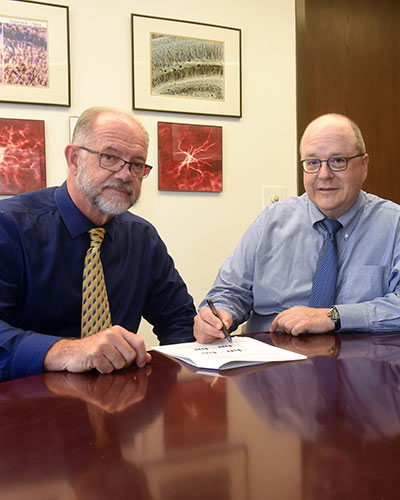February 26, 2018 | David Kohn

Elastic frame design reduces blast acceleration up to 80 percent; technology could be adapted for vehicle bumpers, other uses
Researchers from the University of Maryland School of Medicine (UMSOM) and the University of Maryland A. James Clark School of Engineering have developed a new military vehicle shock absorbing device that may protect troops from traumatic brain injury (TBI) after a land mine blast. Over the past 18 years of conflicts in Iraq and Afghanistan, more than 250,000 troops have suffered such injuries.
The research, conducted jointly by Gary Fiskum, PhD, M. Jane Matjasko Professor for Research and Vice-Chair, Department of Anesthesiology at UMSOM, and William Fourney, PhD, Associate Dean of the Clark School, Keystone Professor of Aerospace and Mechanical Engineering and Director of the Dynamic Effects Laboratory is supported by the University of Maryland Strategic Partnership: MPowering the State, a collaboration between the University of Maryland, Baltimore (UMB) and the University of Maryland, College Park (UMCP).
New approach to study of blast-induced TBI
Prior to this study, most research in this area focused on the effects of rapid changes in barometric pressure, also known as overpressure. “This is the only research so far to model the effects of under-vehicle blasts on the occupants,” said Dr. Fiskum. “We have produced new insights into the causes of TBI experienced by vehicle occupants, even in the absence of significant pressure changes.” The research has led to the development of materials and vehicle frame design that greatly reduce injury caused by under-vehicle explosions.

“Intense acceleration can destroy synapses, damage nerve fibers, stimulate neuroinflammation, and damage the brain’s blood vessels,” said Dr. Fiskum. The researchers also elucidated the molecular mechanisms responsible for this form of TBI.
The findings are described in articles published in the Journal of Trauma and Acute Care Surgery, with Julie Proctor, MS, UMSOM lab manager, as primary author, and in Experimental Neurology, with Flaubert Tchantchou, PhD, UMSOM research associate, as primary author, and in the Journal of Neurotrauma, with Rao Gullapalli, PhD, UMSOM professor of diagnostic radiology, as senior author.
Mitigating G-force experienced by vehicle occupants
Dr. Fourney, Ulrich Leiste, PhD, assistant research engineer in the Clark School’s Department of Aerospace Engineering, and doctoral researcher Jarrod Bonsmann, PhD, developed highly advanced shock absorber designs that incorporate polyurea-coated tubes and other structures to reduce reducing the blast acceleration experienced by vehicle occupants by up to 80 percent.
“Essentially, it spreads out the application of force,” Dr. Fourney said. “Polyurea is compressible and rebounds following compression, resulting in an excellent ability to decrease the acceleration,” he says.
These results were combined with those of Dr. Tchantchou, who demonstrated that mitigation of g-force by the elastic frame designs virtually eliminates the behavioral alterations in lab rats and loss of neuronal connections observed using small scale vehicles with fixed frames, as published in the Journal of Neurotrauma.
Peter Rock, MD, MBA, Martin Helrich Chair of the Department of Anesthesiology, noted, “The research team has addressed an important clinical problem by identifying a novel mechanism to explain TBI, engineered a solution to the problem, and convincingly demonstrated improvements in morphology and behavior. This work has important implications for improving outcomes in military blast-induced TBI and might be applicable to causes of civilian TBI, such as car crashes.”
Continued collaboration between the labs of Drs. Fiskum and Fourney has the potential to lead to the next generation of armor-protected military vehicles that will further protect occupants. An important next step will be testing a larger scale model. “If the data holds up for those, it will hold true for full scale,” Dr. Fiskum said.
Project development funding
As part of MPowering the State, initial funding was provided by a 2009 UMB - UMCP collaborative seed grant awarded to Drs. Fiskum and Fourney. In 2013, the two were awarded a $1.5 million contract by the US Army to support their research using small-scale models of under-vehicle explosions. An additional grant of $2.6 million was awarded by the US Air Force, demonstrating that increasing the cabin pressure in airplanes during air-evacuation of trauma patients to a level greater than what is currently used improves outcomes following exposure of rats to TBI caused by under-vehicle explosions, as published in the Journal of Trauma and Acute Care Surgery.
“Given the complexities of today’s global health challenges, innovative discoveries are increasingly coming from the collaboration between disciplines, such as medicine and engineering," said E. Albert Reece, MD, PhD, MBA, Executive Vice President for Medical Affairs, UM Baltimore, and the John Z. and Akiko K. Bowers Distinguished Professor and Dean, University of Maryland School of Medicine. “We are proud that the School of Medicine is working in partnership with other entities across the University System of Maryland, so that we can maximize the impact we are having.”
About University of Maryland Strategic Partnership: MPowering the State
The University of Maryland Strategic Partnership: MPowering the State brings together two universities of distinction to form a new collaborative partnership. Harnessing the resources of each, the University of Maryland, College Park and the University of Maryland, Baltimore will focus the collective expertise on critical statewide issues of public health, biomedical informatics, and bioengineering. This collaboration will drive an even greater impact on the state, its economy, the job market, and the next generation of innovators. The joint initiatives will have a profound effect on productivity, the economy, and the very fabric of higher education.
About the University of Maryland School of Medicine
Commemorating its 210th Anniversary, the University of Maryland School of Medicine was chartered in 1807 as the first public medical school in the United States. It continues today as one of the fastest growing, top-tier biomedical research enterprises in the world -- with 43 academic departments, centers, institutes, and programs; and a faculty of more than 3,000 physicians, scientists, and allied health professionals, including members of the National Academy of Medicine and the National Academy of Sciences, and a distinguished recipient of the Albert E. Lasker Award in Medical Research. With an operating budget of more than $1 billion, the School of Medicine works closely in partnership with the University of Maryland Medical Center and Medical System to provide research-intensive, academic and clinically-based care for more than 1.2 million patients each year. The School has over 2,500 students, residents, and fellows, and nearly $450 million in extramural funding, with most of its academic departments highly ranked among all medical schools in the nation in research funding. As one of the seven professional schools that make up the University of Maryland Baltimore campus, the School of Medicine has a total workforce of nearly 7,000 individuals. The combined School and Medical System (“University of Maryland Medicine”) has an annual budget of nearly $6 billion and an economic impact in excess of $15 billion on the state and local community. The School of Medicine faculty, which ranks as the 8th-highest public medical school in research productivity, is an innovator in translational medicine, with 600 active patents and 24 start-up companies. The School works locally, nationally, and globally, with research and treatment facilities in 36 countries around the world. Visit medschool.umaryland.edu/
About University of Maryland, College Park
The University of Maryland, College Park is the state's flagship university and one of the nation's preeminent public research universities. A global leader in research, entrepreneurship and innovation, the university is home to more than 37,000 students, 9,000 faculty and staff, and 250 academic programs. Its faculty includes three Nobel laureates, three Pulitzer Prize winners, 56 members of the national academies and scores of Fulbright scholars. The institution has a $1.9 billion operating budget, and secures $560 million annually in external research funding. For more information about the University of Maryland, College Park, visit www.umd.edu.
About the University of Maryland, Baltimore
Founded in 1807, the University of Maryland, Baltimore is Maryland’s only public health, law, and human services university, dedicated to excellence in education, research, clinical care, and public service. UMB enrolls 6,500 students in six nationally ranked professional schools — medicine, law, dentistry, pharmacy, nursing, and social work — and an interdisciplinary Graduate School. The university provides more than $40 million each year in uncompensated care to Maryland citizens, and receives more than $500 million in extramural research funding annually. For more information about the University of Maryland, Baltimore, visit www.umaryland.edu.
Links to reference articles:
Journal of Trauma and Acute Care Surgery
Contact
Office of Public Affairs
655 West Baltimore Street
Bressler Research Building 14-002
Baltimore, Maryland 21201-1559
Contact Media Relations
(410) 706-5260
Related stories

Thursday, June 14, 2018
New Research Finds That Too Much Oxygen Can Harm Cardiac Arrest Patients
For years, researchers have debated whether the use of pure oxygen was a good idea for treating cardiac arrest victims. Two University of Maryland School of Medicine (UMSOM) researchers helped pioneer the idea that this treatment could actually harm the brains of cardiac arrest patients. Now, after decades of research a new clinical study for the first time provides clear evidence that their approach appears to be correct.
